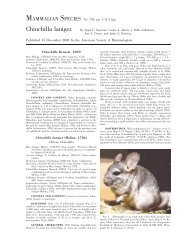MAKING SOLID SOLUTIONS WITH ALKALI ... - Smith College
MAKING SOLID SOLUTIONS WITH ALKALI ... - Smith College
MAKING SOLID SOLUTIONS WITH ALKALI ... - Smith College
Create successful ePaper yourself
Turn your PDF publications into a flip-book with our unique Google optimized e-Paper software.
PART II. OTHER EXPERIMENTS<br />
Precipitation from an Aqueous Solution<br />
• Both halite and sylvite are highly soluble in aqueous solutions. Dissolve 1-2 grams of your<br />
NaCl-KCl reagent mix in 10-20 cc of distilled water, stirring well.<br />
• Evaporate the solution and collect powder x-ray diffraction data on the precipitate that remains.<br />
• Explain your results.<br />
Effects from Grinding<br />
• Prepare a solid solution sample from an alkali halide melt as described in Part I and collect x-<br />
ray data after a light crushing.<br />
• Grind the sample vigorously in a mortar and then collect x-ray data again.<br />
• Explain your result.<br />
Effect of Water<br />
• Prepare a solid solution sample from an alkali halide melt as described Part I and collect x-ray<br />
data after a light crushing.<br />
• Grind the sample gently, but add a few drops of water to the mortar.<br />
• Collect x-ray data and explain your result.<br />
Melting Temperature<br />
• Measure the melting temperature for a series of alkali halide crystals ranging in composition<br />
from pure NaCl to pure KCl.<br />
• Graph the measured melting temperatures as a function of composition in the NaCl-KCl<br />
system.<br />
• Your answer may differ if you start with a halite-sylvite mixture or with an alkali halide solid<br />
solution crystal prepared as in Part I. Why?<br />
Breaking Solid Solutions<br />
• Prepare a suite of solid solution samples from an alkali halide melt, as described Part I, and<br />
collect x-ray for them as described above.<br />
• Anneal the samples in a 450°C oven (for 15 minutes?).<br />
• Collect x-ray data on your sample and explain what your see.<br />
• Repeat this experiment at other temperatures (350-500°C ?).<br />
• Graph your data.<br />
• Compare your results to the alkali feldspar phase diagram.<br />
REFERENCES<br />
Barrett, W.T., and Wallace, W.E. (1954) Studies of NaCl-KCl solid solutions. I. Heats of<br />
formation, lattice spacings, densities, Schottky defects and mutual solubilities: Journal of the<br />
American Chemical Society, 76, 366-369.<br />
Levin, E.M., Robbins, C.R., and McMurdie, H.F. (1964) Phase Diagrams for Ceramists: The<br />
American Ceramic Society, Columbus, 601p.<br />
3

















